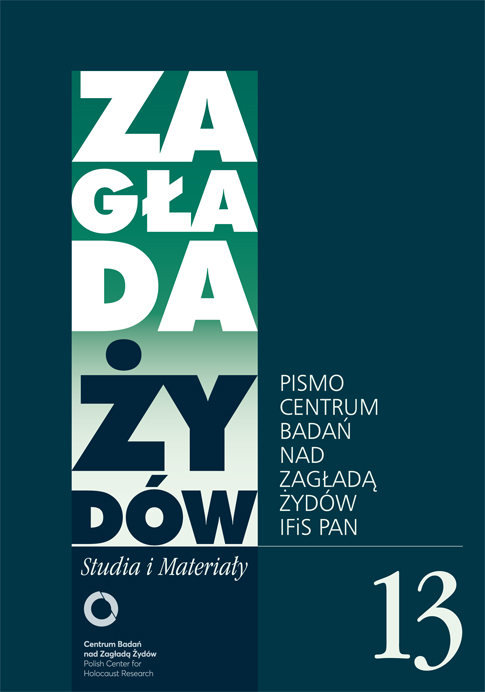Bernard Mark, powstanie w getcie warszawskim i proces Jürgena Stroopa
Zagłada Żydów. Studia i Materiały, Nr 13 (2017), Strony: 181-202
Data zgłoszenia: 2020-10-17Data publikacji: 2017-12-03
 https://doi.org/10.32927/ZZSiM.356
https://doi.org/10.32927/ZZSiM.356
Abstrakt
Jürgen Stroop, the SS general who led the liquidation of the Warsaw Ghetto and the suppression of the Warsaw Ghetto Uprising in April–May 1943, was convicted by a Polish court in 1951 and executed in 1952. Bernard (Ber) Mark (1908–1966), Holocaust historian and director of the Jewish Historical Institute in Warsaw, provided expert testimony for the prosecution at Stroop’s trial. Mark felt constrained to graft a communist-inflected narrative onto his account of the Warsaw Ghetto Uprising and to shoehorn it into his expert testimony in court and then into his interpretation of the trial for a Jewish audience. He did his best to give the Jewish Fighting Organization, which spearheaded the uprising, and its Jewish fighters their due at a time when expression of unvarnished appreciation for Jewish heroism was risky, even while he was paying overrated tribute to the communist underground for its assistance to the Jewish rebels during the uprising. But he always stopped short of the line between conformity to and defiance of the communist regime
Słowa kluczowe
Bernard Mark , Żydowski Instytut Historyczny , powstanie w getcie warszawskim , proces Jürgena Stroopa
Licencja
Prawa autorskie (c) 2017 Autor & "Zagłada Żydów. Studia i Materiały"

Utwór dostępny jest na licencji Creative Commons Uznanie autorstwa 4.0 Międzynarodowe.
https://creativecommons.org/licenses/by/4.0
Inne teksty tego samego autora
- Gabriel Finder, Proces Szepsla Rotholca a polityka kary w następstwie Zagłady , Zagłada Żydów. Studia i Materiały: Nr 2 (2006)
- Gabriel Finder, Svenja Bethke, Dance on the Razor’s Edge:Crime and Punishment in the Nazi Ghettos [Gabriel N. Finder] , Zagłada Żydów. Studia i Materiały: Nr 17 (2021)
Podobne artykuły
- Aleksandra Bańkowska, Weronika Romanik, Podziemne Archiwum Getta Białostockiego. Archiwum Mersika–Tenenbauma , Zagłada Żydów. Studia i Materiały: Nr 9 (2013)
- Marta Janczewska, Perec Opoczyński, Reportaże z getta warszawskiego , Zagłada Żydów. Studia i Materiały: Nr 5 (2009)
- Andrzej Żbikowski, Goetz Aly, Hitlers Volksstaat. Raub, Rassenkrieg und nationaler Sozialismus , Zagłada Żydów. Studia i Materiały: Nr 1 (2005)
- Rachela Auerbach, Karolina Szymaniak, Monika Polit, Treblinka. Reportaż [tłum. i przyp. Karolina Szymaniak, oprac. Monika Polit] , Zagłada Żydów. Studia i Materiały: Nr 8 (2012)
- Agata Jankowska, Powojenne fotografie z obozów śmierci jako specyficzna odmiana ikonografii Zagłady i przykład fotografii forensycznej. Przypadek Bełżca i Treblinki , Zagłada Żydów. Studia i Materiały: Nr 17 (2021)
- Zofia Wóycicka, Sarah Gunsburger, National Policy, Global Memory: The Commemoration of the „Righteous” from Jerusalem to Paris, 1942–2007 , Zagłada Żydów. Studia i Materiały: Nr 13 (2017)
- Justyna Koszarska-Szulc, Ewa Koźmińska-Frejlak, Po Zagładzie. Praktyki asymilacyjne ocalałych jako strategie zadomawiania się w Polsce (1944/45–1950) , Zagłada Żydów. Studia i Materiały: Nr 19 (2023)
- Marta Janczewska , Official Medical Documents as a Source for Research of the Fate of Warsaw Jews 1939–1941 , Zagłada Żydów. Studia i Materiały: Nr Holocaust Studies and Materials (2013)
- Aleksandra Bańkowska, Partyzantka polska lat 1942–1944 w relacjach żydowskich , Zagłada Żydów. Studia i Materiały: Nr 1 (2005)
- Andrzej Żbikowski, Teksty pogrzebane w niepamięci. Relacje dwóch uciekinierek z masowego grobu Poniatowa , Zagłada Żydów. Studia i Materiały: Nr 1 (2005)
<< < 1 2 3 4 5 6 7 8 9 10 11 12 13 14 15 16 17 18 19 20 21 22 23 24 25 26 27 28 29 30 31 32 33 34 35 36 37 38 39 40 41 42 43 44 45 46 47 48 > >>
Możesz również Rozpocznij zaawansowane wyszukiwanie podobieństw dla tego artykułu.
 English
English
 Język Polski
Język Polski



 https://orcid.org/0000-0003-2829-3979
https://orcid.org/0000-0003-2829-3979





